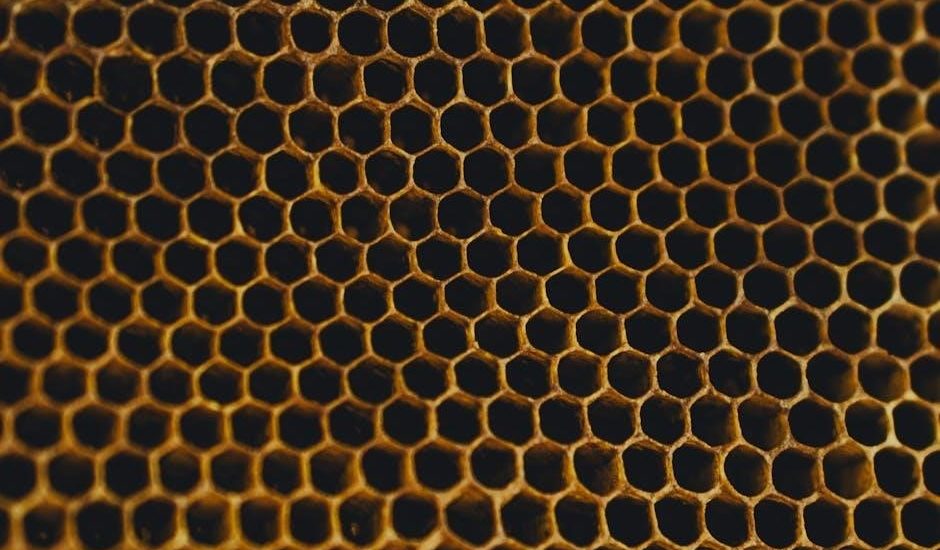The cell is the fundamental unit of life, serving as the basic structural and functional component of all living organisms. Its structure includes the cell membrane, cytoplasm, and organelles, each performing specific functions essential for survival and reproduction.
1.1 Definition of a Cell
A cell is the smallest structural and functional unit of living organisms, capable of independent existence and reproduction. According to the cell theory, all life originates from pre-existing cells. The cell is a self-contained system with defined boundaries, specialized organelles, and genetic material, enabling it to perform essential life processes such as metabolism, growth, and reproduction. Its structure and functions are fundamental to understanding life at the molecular and cellular levels.
1.2 Importance of Studying Cell Structure and Function
Understanding cell structure and function provides insights into the mechanisms of life, disease, and processes like growth and reproduction. It aids in advancing medical treatments, developing therapies, and understanding cellular responses to environmental changes. Studying cells helps in identifying abnormalities, such as cancer, and developing targeted therapies. This knowledge is crucial for advancements in biology, medicine, and biotechnology, offering a foundation for understanding complex biological systems and their applications in real-world scenarios.

Cell Membrane
The cell membrane is a thin, semi-permeable structure composed of a phospholipid bilayer and embedded proteins. It regulates the movement of substances, protects the cell, and facilitates communication.
2.1 Structure of the Cell Membrane
The cell membrane is a thin, semi-permeable structure composed primarily of a phospholipid bilayer with embedded proteins. These proteins act as receptors, channels, or enzymes, facilitating various functions. The phospholipids form the basic framework, while cholesterol in animal cells regulates membrane fluidity. This dynamic structure allows the membrane to maintain cellular integrity while enabling selective transport of substances, ensuring proper communication and nutrient exchange for cellular survival. Its adaptability is crucial for maintaining homeostasis and enabling cellular responses to environmental changes.
2.2 Functions of the Cell Membrane
The cell membrane performs several critical functions, including controlling the movement of substances in and out of the cell. It acts as a protective barrier, maintaining internal conditions essential for cellular processes. The membrane also facilitates communication through signaling molecules, enabling cells to respond to external stimuli. Additionally, it plays a role in cell recognition and adhesion, which are vital for tissue formation and immune responses. These functions ensure the cell’s survival, proper interaction with its environment, and overall physiological balance.
2.3 Types of Transport Across the Cell Membrane
The cell membrane facilitates various transport mechanisms to maintain cellular homeostasis. Passive transport includes diffusion (movement of substances from high to low concentration), osmosis (water diffusion), and facilitated diffusion (via membrane proteins). Active transport requires energy to move substances against concentration gradients, often using pumps. Endocytosis and exocytosis involve the transport of large molecules or particles via vesicles. These processes ensure the cell can acquire nutrients, expel waste, and regulate its internal environment efficiently.

Cell Wall
The cell wall provides structural support, protection, and maintains cell shape. It is composed of materials like cellulose in plants and peptidoglycan in bacteria, preventing excessive water absorption.
3.1 Structure and Composition of the Cell Wall
The cell wall is a rigid, outer layer that varies in composition across organisms. In plants, it consists of cellulose, hemicellulose, and pectin, providing structural support and rigidity. Bacterial cell walls are made of peptidoglycan, maintaining shape and preventing lysis. The cell wall protects the cell from external damage and regulates water uptake, ensuring osmotic balance. Its composition and structure are adapted to specific functional needs, such as mechanical strength in plants or shape maintenance in bacteria.
3.2 Functions of the Cell Wall
The cell wall provides structural support, protection, and maintains the cell’s shape. It prevents excessive water absorption, avoiding cell rupture, and offers mechanical strength. In plants, it facilitates growth by allowing cell expansion. Additionally, it acts as a barrier against pathogens and external stress, ensuring cellular integrity and stability. These functions are critical for the survival and proper functioning of plant and bacterial cells, enabling them to thrive in various environments while maintaining their structural and functional integrity.
3.3 Differences Between Plant and Bacterial Cell Walls
Plant cell walls are composed of cellulose and pectin, providing rigidity and support, while bacterial cell walls are made of peptidoglycan, offering shape and osmotic stability. Plant walls have plasmodesmata for intercellular communication, absent in bacteria. Bacterial walls are thinner and lack the structural complexity of plant walls, reflecting their distinct functional roles in plants versus bacteria. These differences underscore their specialized adaptations to environmental and organismal needs, ensuring survival and proper cellular function in diverse contexts.

Cytoplasm
Cytoplasm is the jelly-like substance within the cell membrane, housing organelles and vital biochemical reactions. It facilitates metabolic processes, signaling, and maintains cell shape and stability, ensuring proper function.
4.1 Definition and Composition of Cytoplasm
Cytoplasm is the jelly-like substance inside the cell membrane, consisting of water, salts, sugars, amino acids, and organelles. It serves as the medium for metabolic reactions, providing a platform for cellular processes. The cytosol, the liquid part of cytoplasm, contains enzymes and nutrients, while the cytoskeleton provides structural support and aids in cell movement and division, ensuring proper cell function and organization.
4.2 Role of Cytoplasm in Cell Function
Cytoplasm is a dynamic medium essential for cell function, facilitating metabolic processes and maintaining cell shape. It enables the movement of organelles and the transport of nutrients, waste, and signaling molecules. The cytoskeleton within cytoplasm provides structural support and aids in cell division and movement. Additionally, cytoplasm acts as a site for key biochemical reactions, supporting the cell’s ability to grow, reproduce, and respond to external stimuli, making it vital for overall cell health and functionality.
4.3 Cytoskeleton: Structure and Function
Cytoskeleton is a complex network of filaments that provides structural support and shape to the cell. Comprising microtubules, microfilaments, and intermediate filaments, it plays a crucial role in maintaining cell shape and mechanical stability; The cytoskeleton facilitates cell movement, intracellular transport of organelles, and cell division. It also anchors organelles and maintains their positions, ensuring proper cell function and responses to external stimuli, making it essential for cell survival and activity.

Cell Nucleus
The nucleus is a membrane-bound organelle found in eukaryotic cells, housing most of the cell’s genetic material. It regulates cell growth, metabolism, and reproduction, acting as the control center for hereditary information.
5.1 Structure of the Nucleus
The nucleus is a membrane-bound organelle in eukaryotic cells, surrounded by a double-layered nuclear envelope. It contains the nucleolus, where ribosome synthesis occurs, and chromatin, which houses genetic material. The nuclear envelope is punctuated by nuclear pores, allowing selective transport of molecules. Inside, chromatin is organized into coils, facilitating DNA replication and transcription. This complex structure enables the nucleus to regulate cell activities effectively. The nuclear matrix provides additional support for these processes.
5.2 Functions of the Nucleus
The nucleus serves as the control center of eukaryotic cells, housing most of the genetic material. It regulates gene expression by controlling DNA replication and transcription. The nucleus directs cell growth, metabolism, and reproduction by producing mRNA for protein synthesis. It also plays a role in apoptosis and responds to external signals. The nucleus ensures the transmission of genetic information during cell division, maintaining the continuity of life and enabling the cell to adapt to environmental changes effectively. This centralizes cellular control mechanisms.
5.3 Nucleolus and Its Role in Protein Synthesis
The nucleolus is a specialized region within the nucleus, primarily responsible for ribosome synthesis. It coordinates the transcription of rRNA genes and assembles ribosomal subunits. These subunits are then transported to the cytoplasm, where they play a crucial role in translating mRNA into proteins. The nucleolus ensures the proper production and assembly of ribosomes, making it essential for protein synthesis and, consequently, for cell growth and function. This process highlights its importance in maintaining cellular activity and overall survival.

Cell Organelles
Cell organelles are essential for various cellular operations. Key organelles include mitochondria (energy production), ER (protein synthesis), Golgi apparatus (protein modification), lysosomes (digestion), and vacuoles (storage).
6.1 Mitochondria: Structure and Function
Mitochondria are known as the “powerhouses” of eukaryotic cells. Their structure includes a double membrane, with the inner membrane forming folds called cristae. This increases the surface area for ATP production through cellular respiration. The mitochondrial matrix contains enzymes for the citric acid cycle; They generate most of the cell’s energy, essential for metabolic processes and maintaining cellular function. Their dysfunction is linked to various diseases, highlighting their critical role in cell health.
6.2 Endoplasmic Reticulum (ER) and Its Types

The Endoplasmic Reticulum (ER) is a network of membranes connected to the nuclear membrane. It plays a key role in protein synthesis, transport, and storage. There are two types: rough ER, covered with ribosomes for protein synthesis, and smooth ER, involved in lipid synthesis and detoxification. The rough ER processes proteins for secretion or cellular use, while the smooth ER synthesizes lipids and metabolizes drugs. Both types are essential for maintaining cellular homeostasis and specialized functions.
6.3 Golgi Apparatus: Structure and Function
The Golgi apparatus is a complex organelle composed of flattened sacs (cisternae) and associated tubules. Its primary functions include modifying, sorting, and packaging proteins and lipids synthesized by the endoplasmic reticulum. Proteins are transported through the Golgi in vesicles, where they are altered by adding carbohydrates or other molecules. The processed molecules are then packaged into vesicles for transport to their final destinations, such as lysosomes, the cell membrane, or secretion outside the cell. This process is critical for cellular logistics and function.
6.4 Lysosomes and Their Role in Digestion
Lysosomes are membrane-bound organelles filled with digestive enzymes, responsible for breaking down cellular waste, debris, and foreign substances. They fuse with vesicles containing material to be digested, releasing enzymes that degrade the contents. This process, called autophagy, recycles cellular components and maintains cellular cleanliness. Lysosomes also play a role in immune responses by destroying pathogens. Their acidic interior ensures optimal enzyme activity, making them essential for cellular digestion and overall cellular health.
6.5 Vacuoles: Structure and Function
Vacuoles are fluid-filled sacs surrounded by a single membrane, primarily found in plant and animal cells. They are larger and more prominent in plant cells, where they store water, salts, and other substances, helping maintain cell shape and turgidity. Vacuoles also isolate waste products and recycle cellular components. In some cells, they store pigments or nutrients. Their flexible structure allows them to expand or shrink, playing a key role in cellular storage and maintaining internal balance.

Cell Types
Cell types are categorized based on their structure and complexity. Prokaryotic cells, like bacteria, lack a nucleus, while eukaryotic cells, including plants, animals, and fungi, have a nucleus and organelles. Understanding these distinctions is crucial for cellular biology.
7.1 Prokaryotic Cells
Prokaryotic cells are the simplest form of life, lacking a nucleus and membrane-bound organelles. Their structure includes a cell wall, plasma membrane, and cytoplasm containing genetic material, ribosomes, and essential enzymes. These cells are highly efficient in reproduction and metabolism, primarily found in bacteria and archaea. Their ability to thrive in diverse environments makes them fundamental to ecosystems and industries like agriculture and biotechnology.
7.2 Eukaryotic Cells
Eukaryotic cells are more complex than prokaryotic cells, featuring a nucleus and membrane-bound organelles like mitochondria, endoplasmic reticulum, and Golgi apparatus. These structures enable specialized functions, such as energy production, protein synthesis, and cell division. Eukaryotic cells are found in plants, animals, fungi, and protists, allowing for greater cellular diversity and advanced biological processes. Their intricate organization supports complex life forms and tissues, making them indispensable in multicellular organisms.
7.3 Comparison Between Prokaryotic and Eukaryotic Cells
Prokaryotic cells lack a nucleus and membrane-bound organelles, whereas eukaryotic cells have these structures, enabling greater complexity. Prokaryotes are smaller, with circular DNA, while eukaryotic DNA is linear and organized into chromosomes. Cell walls are present in both but differ in composition. Eukaryotic cells undergo mitosis, while prokaryotes reproduce via binary fission. Eukaryotes are found in plants, animals, and fungi, whereas prokaryotes include bacteria and archaea, reflecting distinct evolutionary paths and functional capabilities.

Cell Cycle and Division
The cell cycle includes phases like interphase (G1, S, G2) and mitosis (M phase), ensuring DNA replication and equal distribution to daughter cells, crucial for growth and reproduction.
8.1 Phases of the Cell Cycle
The cell cycle consists of two main phases: interphase and the mitotic (M) phase. Interphase is divided into G1 (gap 1), S (synthesis), and G2 (gap 2), during which the cell grows, replicates DNA, and prepares for division. The M phase includes mitosis and cytokinesis, where the cell divides into two daughter cells. Checkpoints regulate progression through each phase, ensuring proper cell health and function before proceeding to the next stage of the cycle.
8.2 Process of Mitosis
Mitosis is a critical process where a eukaryotic cell divides into two genetically identical daughter cells. It begins with prophase, where chromosomes condense, and the spindle forms. In metaphase, chromosomes align at the cell’s center. Anaphase follows, with sister chromatids separating to opposite poles. Finally, telophase occurs, where nuclear envelopes reform, and cytoplasmic division completes the cycle. This ensures each daughter cell receives an exact copy of the parent cell’s DNA, maintaining genetic continuity.
8.3 Regulation of the Cell Cycle
The cell cycle is tightly regulated by checkpoints that ensure each phase is completed accurately before progressing. Cyclins and cyclin-dependent kinases (CDKs) drive cell cycle transitions. The anaphase-promoting complex (APC) triggers the transition from metaphase to anaphase. Checkpoints monitor DNA integrity and chromosome alignment, halting the cycle if errors are detected. Dysregulation can lead to uncontrolled cell growth, contributing to cancer. These mechanisms ensure proper cell division, maintaining genomic stability and preventing abnormalities in daughter cells.

The cell is the fundamental unit of life, with its structure and function enabling organisms to grow, reproduce, and respond to stimuli. Understanding these processes is crucial for advancing biological and medical knowledge.
9.1 Summary of Key Concepts
The cell is the basic structural and functional unit of life, consisting of components like the cell membrane, cell wall, nucleus, and organelles. Each part has specific roles, such as the cell membrane controlling substance movement, the nucleus storing genetic material, and organelles performing specialized functions like energy production. Understanding these structures and their interactions is essential for grasping life processes and advancing medical and biological research.
9.2 Importance of Understanding Cell Structure and Function
Understanding cell structure and function is crucial for advancing medical and biological sciences. It provides insights into life processes, disease mechanisms, and therapeutic interventions. Knowledge of cell components aids in drug development and understanding cellular responses to pathogens. This understanding is vital for diagnosing and treating diseases, as well as for advancing agricultural and biotechnological innovations. Studying cells helps unravel the complexities of life, enabling breakthroughs in health and technology.





